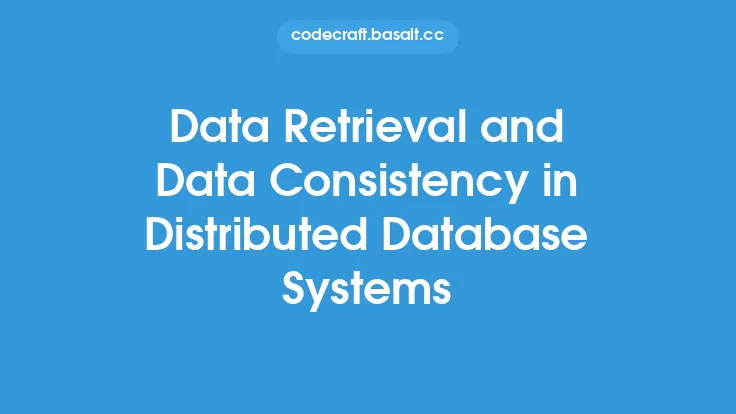When designing and implementing database systems, data retrieval is a critical aspect that can significantly impact the performance, scalability, and maintainability of the system. Data retrieval patterns and anti-patterns refer to the approaches and techniques used to retrieve data from a database, and understanding these patterns and anti-patterns is essential for building efficient and effective database systems. In this article, we will delve into the world of data retrieval patterns and anti-patterns, exploring the different types, their characteristics, and the implications of using them in database systems.
Introduction to Data Retrieval Patterns
Data retrieval patterns are proven solutions to common data retrieval problems. They provide a standardized approach to retrieving data from a database, making it easier to develop, maintain, and optimize database systems. Data retrieval patterns can be categorized into several types, including data access patterns, data retrieval algorithms, and data caching patterns. Each type of pattern has its own strengths and weaknesses, and understanding these patterns is crucial for selecting the most appropriate approach for a given use case.
Data Access Patterns
Data access patterns refer to the techniques used to access and retrieve data from a database. Common data access patterns include the Repository pattern, the Data Access Object (DAO) pattern, and the Active Record pattern. The Repository pattern provides a layer of abstraction between the business logic and the database, making it easier to switch between different databases or data storage systems. The DAO pattern provides a standardized interface for accessing and retrieving data, while the Active Record pattern combines the data access and business logic into a single entity.
Data Retrieval Algorithms
Data retrieval algorithms refer to the techniques used to retrieve data from a database. Common data retrieval algorithms include the SQL query algorithm, the indexing algorithm, and the caching algorithm. The SQL query algorithm uses SQL queries to retrieve data from a database, while the indexing algorithm uses indexes to improve the performance of data retrieval. The caching algorithm stores frequently accessed data in a cache, reducing the need to retrieve data from the database.
Data Caching Patterns
Data caching patterns refer to the techniques used to cache data retrieved from a database. Common data caching patterns include the Cache-Aside pattern, the Read-Through pattern, and the Write-Through pattern. The Cache-Aside pattern caches data retrieved from the database, while the Read-Through pattern caches data retrieved from the database and updates the cache when the data changes. The Write-Through pattern caches data retrieved from the database and updates the cache and the database when the data changes.
Anti-Patterns in Data Retrieval
Anti-patterns in data retrieval refer to approaches and techniques that should be avoided when retrieving data from a database. Common anti-patterns include the N+1 query problem, the Cartesian product problem, and the over-retrieval problem. The N+1 query problem occurs when an application retrieves data from a database using multiple queries, resulting in poor performance. The Cartesian product problem occurs when an application retrieves data from multiple tables, resulting in a large amount of unnecessary data. The over-retrieval problem occurs when an application retrieves more data than necessary, resulting in poor performance and wasted resources.
Implications of Using Data Retrieval Patterns and Anti-Patterns
The implications of using data retrieval patterns and anti-patterns can be significant. Using proven data retrieval patterns can improve the performance, scalability, and maintainability of a database system, while using anti-patterns can result in poor performance, wasted resources, and maintenance headaches. Understanding data retrieval patterns and anti-patterns is essential for building efficient and effective database systems, and for avoiding common pitfalls and mistakes.
Best Practices for Using Data Retrieval Patterns
To get the most out of data retrieval patterns, it's essential to follow best practices. These include selecting the most appropriate pattern for a given use case, using patterns consistently throughout the application, and avoiding anti-patterns. Additionally, it's essential to monitor and optimize data retrieval performance, using techniques such as indexing, caching, and query optimization.
Common Pitfalls and Mistakes
Common pitfalls and mistakes when using data retrieval patterns include over-reliance on a single pattern, failure to consider the implications of using a pattern, and neglecting to monitor and optimize data retrieval performance. Over-reliance on a single pattern can result in poor performance and maintainability, while failure to consider the implications of using a pattern can result in unexpected consequences. Neglecting to monitor and optimize data retrieval performance can result in poor performance and wasted resources.
Conclusion
In conclusion, data retrieval patterns and anti-patterns are essential concepts in database systems. Understanding these patterns and anti-patterns is crucial for building efficient and effective database systems, and for avoiding common pitfalls and mistakes. By following best practices and selecting the most appropriate pattern for a given use case, developers can improve the performance, scalability, and maintainability of their database systems. Additionally, by avoiding anti-patterns and monitoring and optimizing data retrieval performance, developers can ensure that their database systems are running at optimal levels.





